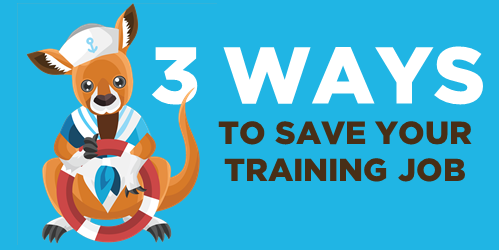
Whenever an organization needs to re-organize or make cuts to its staff, the training people are usually the first on the chopping block. There are a lot of arguments as to why that’s the case but it’s a reality for anyone who’s been in the training industry for a while.
The good thing is that e-learning is still a hot part of the training industry, thus far many of us have been spared. But as the tools become more efficient and others are empowered to build their own training content, there will be a reckoning and we’ll have to continue to show our value.
Here are a few common reasons why training gets the boot and what you can do today to avoid being the one booted.
Training Creates Value
Training is supposed to create value. In an ideal world, training is aligned with the organization’s goals and all training efforts contribute to meeting those goals. But the reality is that not all courses (or what are called courses) focus on performance. And that’s probably why it’s easy to gut training departments when times get tough.
Training Aligns with Business Initiatives.
Often the training department lags behind everyone else and tends to react to what the business is doing. Because of this, plans are made without your input.
When you know that the organization is pushing an agenda, your first thought should be where can I contribute? Then figure out how to make it happen. Learn more about the projects and their objectives. Connect with decision-makers. You’ll be seen as a valuable partner when you’re proactive in helping the organization meet its goals.
Training Connects with Metrics
Training impact should be measurable. However, what’s being measured needs to be meaningful. Years ago I learned that lesson when I shared some metrics with one of our directors. While the metrics were great, they were completely irrelevant to what he needed to make decisions.
Get connected with the numbers people. There’s someone in the organization who tracks performance metrics. Find out who that is and learn more about how they track the metrics. You want to know that your courses are aligned with what’s measured. Often you’ll find that your training focuses on one area but the metrics and incentives tied to them focus on different areas. A financial specialist can help you see that.
Trainers Are Assertive
Training groups tend to be passive and react to the organization’s needs. Instead, the teams should be aligned with the organization’s goals and offer proactive solutions. Sometimes this is out of your hands because you don’t have a seat at the table. However, that can change.
Consider the two previous points above:
- Understand the organization’s goals and push back to ensure your projects are aligned. Worst case you’ll get a better understanding of why you’re doing what you do. However, you may help steer your team towards more productive work.
- Take the initiative to be part of the knowledge network. Most people don’t leverage this resource and kind of go with the flow. That flow may not go where you want it to.
Ideally, you want your work to be aligned with the organization’s critical path. The more you to do assert that goal, the more apt you are to be where you need to be and have your contributions valued.
Don’t remain an order taker. Connect to the organization’s goals and get involved to help influence when training needs to be created. This makes you a better partner focused on productive training courses that help move the organization forward.
Events
Free E-Learning Resources
















0
comments